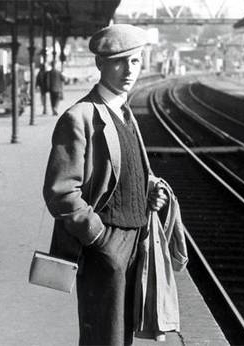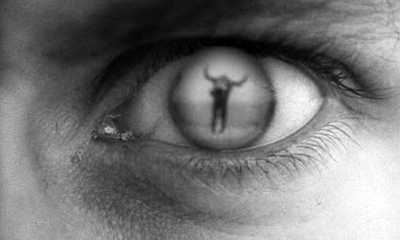Reviewed by Glenn Erickson
England's Imperial War Museum commissioned this feature film to make use of the enormous quantity of WW2 documentary footage in its vaults. Thames TV's The World at War would draw upon the archive, but the Museum wanted something that would show the breadth of their holdings, not just the most sensational footage. Director Stuart Cooper instead chose to express a single soldier's anxieties and fears as he prepares for battle. His 1975 Overlord takes a poetic approach to the combat experience.
The film uses no narration. England is at war. Young Tom (Brian Stirner) is called up for duty and joins uncounted young men preparing to cross the channel on D-Day. Life in camp is boring, and he and his friends Jack (Davyd Harries) and Arthur (Nicholas Ball) get in trouble for minor offenses. Tom meets a beautiful girl (Julie Neesam) at a dance. He promises to see her again, but is called away the very next morning and cannot leave her a message. As the massive armada of men and material forms up, Tom has a recurring vision in which he sees himself felled by a bullet on the Normandy beach.

The average historical documentary will license WW2 stock footage from a commercial film library. But it usually isn't original film from newsreel and combat cameramen. The filmmakers are instead given previous compilation films with film footage most likely obtained by duping other previous compilation films. The beauty of Overlord's access to prime source, original negative film material is twofold. First, the ability to work from the original negative allows one to discover that original combat camerawork is often of excellent quality. Filmed on 35mm, battle scenes have a breathless you-are-there impact that holds up even when enlarged on a giant screen. Secondly, prime source access means not having to settle for an earlier editor's choice of scenes. Newsreels of war action naturally focused on the dynamics of guns firing, men marching and actual combat situations. When one wants to analyze the combat experience, what happened before and after the editor's cuts takes on greater significance. Also, the combat cameramen filmed miles of non-combat footage showing how soldiers really lived, little of which was ever used.
Stuart Cooper went straight for this peripheral material. During the spring of 1944 hundreds of thousands of soldiers were moved into southern England with millions of tons of war equipment, all massing for the D-Day assault. Cooper's narrative breaks away for scenes of air raids softening the French mainland for the invasion, but mostly concentrates on the hurry-up-and-wait misery of the countless young soldiers. Cut off from their normal lives, shifted from camp to camp at a moment's notice and kept completely in the dark, they can't even send a private letter home without it being read by a censor.
When told that viewing everything in the Archive would take nine years, Cooper opted to collect mostly footage concerning troop mobilization and preparation for invasion. Overlord rigorously maintains its documentary truthfulness, in that film shot elsewhere or at a different time was not used. The organization of D-Day is shown in its immensity. We see real divisions marching and traveling by train and truck; endless lines of tanks and landing craft make their way down wooded English lanes. Much of the film has never been seen before and looks as though it were shot yesterday. Editor Jonathan Gili makes sense of miles of footage, often finding serendipitous cuts in random material.

The story of the soldier Tom is cut directly with the archive scenes. Cinematographer John Alcott found old un-coated lenses identical to those used by the combat cameramen, and he filmed as much as possible with 'available light.' We see Tom telling his parents he's leaving and adjusting to the humiliations of regimented army life. He spends a great deal of time alone or with one of his friends, trying not to complain about his situation. The only failing in these scenes is budgetary; the 'Tom' material tends to be under-populated. Tom is pointedly alone on the train to camp, which the film excuses by having him made late by an air raid. But when he arrives at camp and is seen walking alone across an empty parade ground, we can't quite connect Tom with the masses of other soldiers. Stylistically, however, the young man's isolation serves director Cooper's notion that Tom is already a kind of ghost, detached from any sense of group identity.
Cooper's concept definitely strays from the literal plane. A montage of Tom exploring an ancient castle segues into a dramatic (newly filmed) image of a DeHavilland bomber heading East for Europe. That introduces an eye-opening bombing montage. Tom meets a painfully attractive girl at a dance. They're immediately attracted to one another but must part only a few minutes later. When Tom's outfit moves on he's unable to keep their date and cannot contact her. But he continually fantasizes about her in the days ahead.
Most of Tom's fantasies are of what he fears most, being shot dead on the beach. The repeated nightmare begins with an out-of-focus slow motion image of Tom running from afar. Cooper references the famous combat pictures of Robert Capa, but many viewers will be reminded of a stylized flashback in Sergio Leone's Once Upon a Time In the West. Cooper does manage several stunningly surreal images, such as Tom and his girl embracing while standing alone in a landing craft. Tom also imagines himself returning as a corpse. As a substitute for the sex he will never share, his girl is the one to prepare his body for burial, gently undressing him. It's quite touching.

Overlord's bleak ending cuts off the action at the point where pictures like The Longest Day begin. Tom has been imagining his terrible end in romantic terms. When it comes, his fate is devoid of glory or honor. Greatly adding to the film's appeal is Paul Glass's symphonic score, a mellow, plaintive thread that helps many sequences to cohere. A few period songs also stick in the mind, like a pop tune called We Don't Know Where We're Going.
The Criterion Collection's Blu-ray of Overlord improves visually on the earlier excellent DVD release only to the degree that the HD image offers more resolution and a wider contrast range. In the often gray-on-gray images, viewers aren't likely to notice much difference. The Blu-ray encoding does impress with its uncompressed sound, which shows the creativity of the audio work on Overlord. The sounds for everything -- troops, vehicles, machinery -- had to be invented after the fact. In some shots it looks as if lip readers have been employed to help dub new voices.
Director Stuart Cooper was a former actor who played one of Robert Aldrich's criminal commandos in The Dirty Dozen. Cooper and Brian Stirner share a full-length commentary. The only film optical in the movie, they tell us, is the dream image of Tom falling, superimposed in his own eye.
Aspiring film editors will love the extras. The curators of The Imperial War Museum host a tour of the facility and discuss the making of the film in a handsome new featurette, Mining the Archive. A 1943 propaganda film Cameramen at War honors the battlefield film units. Two other propaganda pictures glimpsed briefly in Overlord, 1941's Germany Calling and the comical The Lambeth Walk are seen in their entirety. Stuart Cooper's arresting 1969 short subject A Test of Violence plays graphic tricks with the war paintings of the Spanish artist Juan Genovés. Brian Stirner reads from the journals of two D-Day participants. A trailer is included as well.
The fat insert booklet contains an essay by Kent Jones, a history of the Imperial War Museum and excerpts from a novelization of Overlord by Stuart Cooper and Christopher Hudson.
On a scale of Excellent, Good, Fair, and Poor,
Overlord Blu-ray
rates:
Movie: Excellent
Video: Excellent
Sound: Excellent
Supplements: New featurette Mining the Archive, propaganda films Cameramen at War, Germany Calling and The Lambeth Walk; Stuart Cooper's 1969 short subject A Test of Violence, Brian Stirner reads from the journals of two D-Day participants, Trailer, essay by Kent Jones, A history of the Imperial War Museum, excerpts from a novelization of Overlord by Stuart Cooper and Christopher Hudson.
Deaf and Hearing-impaired Friendly?
YES; Subtitles: English
Packaging: Keep case
Reviewed: May 7, 2014
Republished by permission of Turner Classic Movies.

Text © Copyright 2014 Glenn Erickson
See more exclusive reviews on the Savant Main Page.
The version of this review on the Savant main site has additional images, footnotes and credits information, and may be updated and annotated with reader input and graphics.
Return to Top of Page
|


